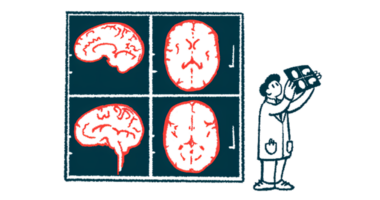AAN 2024: Long-term data support early Kesimpta start in relapsing MS
Outcomes included fewer relapses, reductions in lesions, disability worsening

For people recently diagnosed with multiple sclerosis (MS), first-line treatment with Kesimpta (ofatumumab) was associated with a lower risk of disability progression over starting it after about 2.5 years of using Aubagio (teriflunomide).
That’s according to six years of data spanning the ASCLEPIOS I (NCT02792218) and ASCLEPIOS II (NCT02792231) Phase 3 trials and the ALITHIOS open-label extension study (NCT03650114) that were recently presented at the American Academy of Neurology (AAN) 2024 Annual Meeting.
The findings were shared by Gabriel Pardo, MD, director of the Multiple Sclerosis Center of Excellence at the Oklahoma Medical Research Foundation, in a Novartis-sponsored talk titled, “Longer-term (Up to 6 Years) Efficacy of Ofatumumab in People with Recently Diagnosed and Treatment-Naive Relapsing Multiple Sclerosis.”
“These data build upon the existing efficacy data on Kesimpta and support it as a first-choice treatment option for people recently diagnosed with [relapsing MS],” Norman Putzki, MD, PhD, development unit head of neuroscience and gene therapy at Novartis, said in an email to Multiple Sclerosis News Today. Novartis is the company that markets Kesimpta, a monthly injectable therapy that’s approved in the U.S. for adults with relapsing forms of MS. It works to deplete B-cells, a type of immune cells implicated in the autoimmune attacks that damage the nervous system in MS.
In the ASCLEPIOS trials, Kesimpta was superior to oral Aubagio for suppressing disease activity and slowing disability progression up to 30 months, or about 2.5 years.
Among the subgroup of patients with early disease, that is, who were diagnosed within the last three years and hadn’t had any prior treatment at enrollment, Kesimpta also was associated with a favorable risk/benefit profile and near complete resolution of inflammatory disease activity.
Continuous Kesimpta compared with ‘switch’ treatment
Those who participated in ASCLEPIOS could enter ALITHIOS, where they’re being treated with Kesimpta to assess its long-term safety and effectiveness. Previous analyses showed the treatment had sustained clinical benefits for up to five years of continuous use across the ALITHIOS study population, and for up to four years in the early disease subgroup.
Pardo presented six-year findings from the recently diagnosed patients who received either Kesimpta or Aubagio as their fist-line treatment in the ASCLEPIOS trials. A total of 465 patients from that subgroup were enrolled in ALITHIOS, with 366 still receiving treatment as of a cutoff in September 2023.
Patients who started Kesimpta as a first-line treatment in ASCLEPIOS had 44% fewer overall relapses over six years than those who’d originally been assigned to Aubagio and started Kesimpta as a second-line treatment after the main trials, referred to as the “switch” group.
Over six years, continuous Kesimpta was associated with very low relapse rates, “corresponding to about one relapse every 20 years,” Pardo said. In the switch group, relapse rates quickly dropped by more than 70% after the switch, “getting very close” to relapse rates seen in the continuous group after six years.
A similar pattern was observed with brain lesions, where first-line Kesimpta was associated with 96.4% fewer inflammatory lesions and 82.7% fewer new or enlarging lesions compared with the switch group, although those on Aubagio saw substantial and rapid drops in lesion burden after the switch.
Differences in disability progression
First-line Kesimpta patients had 24.5% fewer three-month confirmed disability worsening (CDW) events — defined as an increase in Expanded Disability Status Scale (EDSS) scores that was sustained for at least three months — and 21.6% less six-month CDW events compared with the delayed start patients. There were also fewer progression events occurring independently of relapses with continuous Kesimpta treatment.
During the main ASCLEPIOS trials, a continuously growing difference could be seen between Kesimpta and Aubagio regarding disability progression. While that stabilized after the latter group switched over, “those patients never catch up,” Pardo explained.
“In recently diagnosed treatment-naïve people with relapsing multiple sclerosis (RMS) who switched from teriflunomide to Kesimpta, improvements across several efficacy outcomes were seen after switching to Kesimpta,” said Putzki. “However, rates of 3- and 6-month confirmed disability worsening events remained higher compared to patients receiving continuous Kesimpta, indicating that the efficacy benefit of first-line Kesimpta on delaying disability worsening was not fully achieved in the switch group.”
By the end of the main trials, around 90% of patients on Kesimpta had achieved no evidence of disease activity (NEDA-3), defined as a lack of relapses, CDW events, and MRI disease activity, which was sustained through six years. In the switch group, only 58.4% had achieved NEDA-3 by the third year, but these patients did achieve similar rates as the continuous group in years four through six.
In “Longer-term Safety and Efficacy of Ofatumumab in People with Relapsing Multiple Sclerosis for Up to 6 Years,”another poster presentation at the AAN meeting, researchers covered six-year results from the entire study population, including patients with a longer time from diagnosis and who had received prior treatment.
Across this larger group, the findings likewise indicated that starting Kesimpta sooner was associated with greater long-term benefits.
As in Pardo’s analysis, the switch group saw rapid drops in relapses and brain lesions after starting Kesimpta, but never fully caught up in disability outcomes.
The findings support “the long-term benefit of earlier initiation of ofatumumab, which cannot be recovered in those initially randomized to teriflunimide,” the researchers said.
Note: The Multiple Sclerosis News Today team is providing coverage of the American Academy of Neurology (AAN) 2024 Annual Meeting April 13-18. Go here to see the latest stories from the conference.







